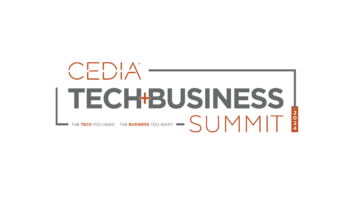Editor’s note: This article from Henry Clifford is targeted toward the custom integrator community, but he has excellent suggestions that can help any independent business. For more business articles from Henry Clifford, visit his author profile here.
We all seem to be moving in the direction of opening back up after the COVID-19 shutdown and the CI channel has a huge opportunity to make up lost ground for the remainder of 2020. Depending on your where you live, integrators were shut down completely, declared essential, or may have been relatively unaffected. No matter your current situation, there’s always room for improvement. Here are some suggestions to help grow your business during and after the coronavirus:
1. Head Outdoors — Adding Outdoor Lighting, Sound, and Video
It’s heating up out there and there’s no better way to socially distance and ring the cash register at the same time than by adding these outdoor technology solutions to your product lineup:
- Outdoor Lighting — A few strong outdoor lighting players are trying to get integrators in the habit of offering outdoor lighting solutions to their customers. Companies like Coastal Source offer design services, sales training, and solid manufacturer rep relationships, enabling any CI business to confidently jump in with both feet. Outdoor lighting can be extremely profitable and reliable, making it a great add-on to your existing customer base.
- Sound — With so many great sounding outdoor audio systems out there right now, it’s easy to offer solutions that fit any budget or application. Client favorites include landscape systems designed to bury in flower beds or bollard-style speakers aimed at producing killer sound across patios and pools. Selling margins can move well north of 50 percent if designed properly, which makes backyard sound a great way to offset lower profits in other areas.
- Video — Outdoor TVs have been around for years, but usually came with a price tag unaffordable for many clients (or at least high enough where they didn’t see the value). Thanks to tech advances over the past few years, these displays are now brighter, sleeker, and cheaper than ever before. Customers tend to run hot and cold when it comes to preferring their TV outdoors; but when they want it, they really want it. By combining desire with affordability, there’s ample opportunity to attach more products by SunBrite, Seura, and others to your backyard repertoire.
See also: Five Ways To Help Employees Work-From-Home Effectively And Efficiently – Coronavirus Or Not
2. Enable Remote Support to Prepare for the Next COVID-19 Wave
If your customers are starting to stir and willing to have you back in their homes, they probably understand COVID-19 may cause the economy to shut down again, necessitating as much contact-free interaction as possible. If you don’t have your systems enabled with remote support products like OvrC or Domotz, take the opportunity to start adding them into your new projects and consider stocking your vans with hubs and network gear for your technicians to easily install on their daily service call routes. Think of it as a great way to put the proverbial “fire” out for your client but leave a “fire extinguisher” behind so the next time you can help them remotely.
Remote support is also a great way to add profit to your bottom line by not having to roll a truck. Every service issue solved remotely drives up customer and employee happiness. Whether you’re providing remote support services yourself or using a Remote Managed Service (RMS) provider like Parasol or OneVision [full disclosure: I’m a co-founder of Parasol], now is the time to deploy remote management for as many of your systems as possible.
3. Develop a Referral Program for your Raving Fans
Most CI businesses get an overwhelming amount of their business from referrals, yet spend very little time focused on growing that very same revenue stream. You’ve done a great job for hundreds of clients. There are a few of them who won’t shut up about how much they love your company. Take the time now to develop a formalized program rewarding both them and the new customers they send your way. Ideas range from handing out gift cards to delivering bottles of wine. Everyone loves to be thanked properly, and it’s amazing what a small token of appreciation will do to encourage repeat business. By formalizing a “Raving Fan” program, you let your most important clients know just how important they are to your business.
Other Raving Fan ideas include asking for referrals at the end of every job by letting your clients know that 80 percent of your business comes from happy clients just like them. Who do they know who might be a good candidate for the services you offer? The biggest challenge with referral programs tends to center around the fact that they’re easy to start, but tough to stick with long term because they’re not easily automated. Effective programs require a lot of human interaction and buy-in across the entire company. Aim to praise your employees publicly who refer in the most business and watch your profits grow in the bargain.
See also: Another View: How To Protect Your Business Against Liabilities Caused By Coronavirus
4. Focus on Eliminating Waste
Most CI businesses run on single-digit net margins. That means every dollar of average integrator revenue translates into, at most, 10 cents worth of profit. Savings are a whole different story, where a dollar saved is a dollar kept. That means saving money inside your company is 10 times more meaningful than selling more services. To illustrate, a cost savings of $25,000 is the equivalent of selling $250,000 worth of new business. As the old adage goes, “revenue is vanity and profit is sanity.”
Consider engaging your employees in small groups of people doing the same work and have them brainstorm ideas around where the company is wasting resources. If you’re like most businesses, it won’t take long to come up with a long, painful list. Pick one and focus on it during the next 90 days as a “Rapid Improvement Plan.” Find out more about helping your company begin its journey towards eliminating waste by reading the book Ownership Thinking: How To End Entitlement and Create a Culture Of Accountability, by Brad Hams.
5. Train, Train, and Train
If you ask your employees what they want the most, chances are they’ll list more training opportunities as a top priority. When business is booming, it’s hard to keep up with the constant demands of day-to-day projects and service work. Now is a great time to enroll in any number of fantastic online training programs and incent your employees to learn as much as they can. CEDIA has been giving away its legacy course content and will begin offering all new paid content on June 1. Other industry players are also leading the charge with programs like ProSource’s newly unveiled “ProSource University,” which features original content and manufacturer training, as well as all of CEDIA’s course content bundled in [full disclosure again: I’m a co-founder of IntegrateU]. Other programs, such as SnapAV’s Snap University and Bedrock Learning’s courses, are aimed at helping teach technical skills in bite-size courses.
In addition to fantastic online training courses, there are a ton of certifications by CEDIA (ESC), Control4 (PCNA), and AVIXA (CTS), which tend to increase employee morale, build organizational credibility, and provide a great excuse for publicly praising recipients when they pass their exams (some of which are pretty challenging). When one of your employees aces a tough exam, don’t miss the opportunity to recognize them in front of their peers.
See also: How To Help Your Employees Feel Successful While Remote Working
6. Write and Share Your Vivid Vision
Cameron Herold’s book Double Double remains a top business book for good reason. Herold recommends writing out what your company looks like (in great detail) in three years using the present tense. He calls it a “Vivid Vision,” and recommends it’s written by the CEO and communicated to employees, customers, and vendors. Having to write a “Vivid Vision” pushes any CEO to push the limits of what they perceive to be possible and nudges an organization toward manufacturing crises for themselves. Any business that isn’t improving isn’t growing. Herold recommends rewriting the “Vivid Vision” in times of change like COVID-19.
What does your business look like in three years? If you haven’t sat down and thought it through, how do you think your employees would respond when asked if they could highlight what your company’s mission, vision, and values are? Times like these are great opportunities to set aside time, shut down the phone, email, and social media, and write, undistracted, until you get it all out on paper. You’re never going to get “there” if it’s undefined. Writing a “Vivid Vision” can be scary and hard, but it’s worth it.
7. Start Measuring Happiness and Encourage Peer Praise
There are a ton of tools out there aimed at helping measure your employee happiness and encouraging them to praise each other. “TinyPULSE” features weekly questions like, “How likely are you to be working here in a year?” Some of the feedback can be sobering early on, but it beats not knowing by a long shot. TinyPULSE’s “Cheers for Peers” offers employees an easy way to praise the co-workers using your core values or just say something nice.
Other tools include “Motivosity,” which offers not only peer praise, but also gives employees a spending account to reward peers with cash, gift cards, and other prizes. Motivosity also has a “spot bonus” feature where anyone can request a cash reward for a colleague or subordinate based on outstanding performance.
If you don’t have a tool in place for measuring your employee’s happiness or encouraging them to make each other happy, you’re missing out. There’s no better time than right now to move this along.
8. Go Commercial
If your residential business is going strong, consider adding commercial installations to your lineup. You can afford to be choosy, and there are plenty of businesses out there who need your help. You might be surprised to find the commercial market double or triple the size of the pond you’re currently swimming in.
There are a ton of ways to differentiate yourself in the Small and Medium Business (SMB) space. Consider a program where all you offer are members-only solutions where clients can subscribe to their AV needs using a model known as AV as a Service (AVaaS). Other entry points include seeking out local IT firms and offering to partner with them. While many IT companies may offer AV, the majority don’t, and either don’t have a relationship with an integrator or may be unhappy with their current vendor. The commercial space is ripe for disruption, and rest assured your margins don’t have to take a hit if you decide to pivot.
9. Rightsize Your Headcount
One of my mentors told me his employees never met a challenge that couldn’t be solved by adding headcount or square footage. While that might seem a condescending and nasty thing to say, it reveals that sometimes we can work at cross purposes. If a business owner’s role is to run an organization efficiently with as few employees as possible, it’s human nature for employees to want the best quality of life while earning the most income. It doesn’t have to be antagonistic (and hopefully it isn’t in your company), but there are industry benchmarks to align around.
Industry experts like VITAL Management’s Steve Firszt have long held that any good integrator should be generating $200,000 in revenue per employee (RPE) per year. It’s simple math. If you have a $2 million company with more than 10 employees, you have a hole in the boat, or should have a good reason why there are too many people onboard.
If you’re not getting $200,000 RPE right now, you can sell your way into the headcount you have or make some staff reductions to align better. Either option is challenging, but you owe it to your employees to make the tough decisions now to ensure long-term viability.
10. Focus on RMR as a Percentage of Operating Expenses (OpEx)
If you’re like most integration businesses, you begin each month having to sell projects or service work to make payroll. Passive income streams like recurring monthly revenue (RMR) tend to make up 10 percent of OpEx in a typical CEPro 100 firm. What if that number was 100 percent? You could wake up on the first of the month and not have to generate a single dollar in new project work.
Imagine a world where you can be more choosy about the clients you take on and never worry about cash flow again. Warren Buffet famously said, “If you don’t find a way to make money while you sleep, you will work until you die.” All of this sounds too good to be true, but it doesn’t have to be.
Consider adding service contracts, security monitoring, 24/7 remote support services, or other passive income streams to your existing customer workflow. A well-run integration business can attach RMR at a rate of 50 percent. Take the deals you did last year and divide by two. That’s how many RMR accounts you could be adding in 2020.
It’s easy to get distracted by the “busy” whirlwind in the day-to-day rhythm of your business. Pick one from this Top 10 list and implement it. When you’re done with that, pick one more. The only way to eat the elephant is one bite at time.
Good luck revitalizing your business as we round out 2020!
This article originally ran on residentialsystems.com.
See also: Working From Home? Here’s How To Give Your Space A Wellness Boost












